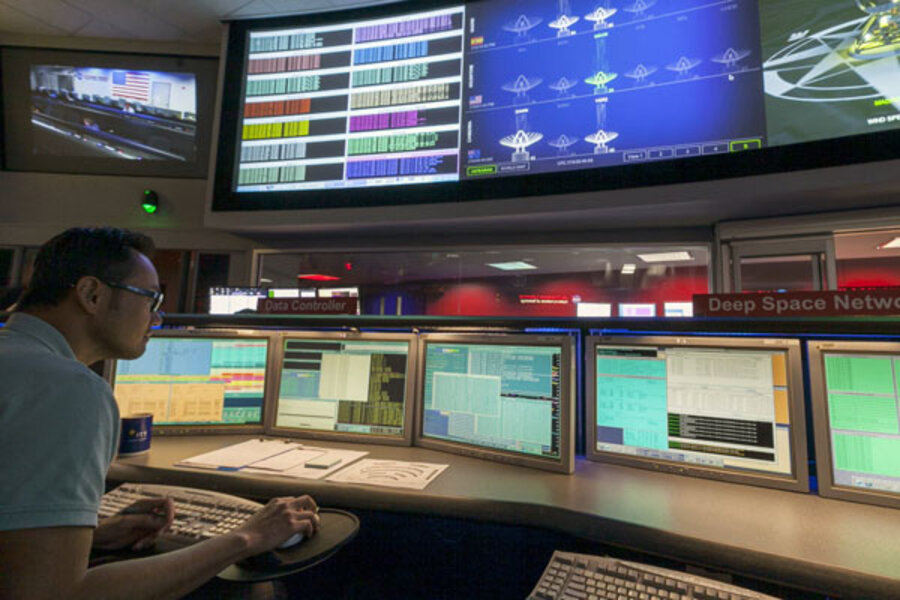Mars mission: Rover Curiosity poised to enter red planet's atmosphere
Loading...
With less then 36 hours left in its eight-month journey to Mars, NASA's robotic explorer Curiosity is in excellent health and on track for a pinpoint encounter with Mars' atmosphere – one that will put it on a path to land on the bottom of Gale Crater at 1:31 a.m. Eastern Daylight Time Monday.
That's the latest assessment from mission managers as the 1-ton rolling chemistry lab and the rocket stage ferrying it begin to feel the tug of Mars' gravity.
The goal of the Mars Science Laboratory (MSL) mission is to look for geological evidence that the crater, and especially the 3-mile-high mountain inside it, might have been capable of hosting life early in the planet's history, when Mars was wetter and warmer than it is today.
For all the excitement – and no small amount of trepidation – as entry hour approaches, time is slowing down somewhat for controllers, acknowledges Richard Cook, deputy project manager for the mission.
On July 30, the rover and descent module shifted to the MSL's equivalent of autopilot. Once reentry begins, events will happen too quickly for humans to intervene, especially given the 14-minute, one-way travel time for radio signals between Earth and Mars. So the craft and its unique reentry system are virtually on their own. Absent any Earth-sent command for a last-minute course correction on Sunday, if needed, it's hands off at mission control at NASA's Jet Propulsion Laboratory.
"Usually when you get to the last day, there's not that much to do other than to wait," says Dr. Cook, who cut his teeth on Mars lander and rover missions as mission manager for the Mars Pathfinder mission, which successfully placed the rover Sojourner Truth on the red planet in 1997. Since then, he's played a key role in the Mars Exploration Rover mission, which sent the rovers Spirit and Opportunity to Mars.
During the prelanding calm, "usually you get a chance to go have coffee with people on the team" and reflect on the accomplishments that got the mission to this point, as well as anticipate the work ahead, Cook said during a briefing Saturday. "Time seems to have a weird sort of rhythm in that last day, where it goes real slow for a long time, then the last 15 minutes it goes like that," he said, with a snap of his fingers.
After a trip of 354 million miles, Curiosity is on course to hit dead on an imaginary 2-mile-long by 7-mile-wide box at the top of Mars' atmosphere – a bulls-eye that sets the rover on its "seven minutes of terror" descent to the 96-mile-wide Gale Crater.
Even if all goes well, Curiosity will be very slow to get rolling.
During its first day on the surface, Curiosity will deploy its main antenna and aim it toward Earth. On Tuesday, it will extend its mast and begin taking pictures with one of the two cameras on top. On Wednesday, engineers will be running "aliveness" tests on the rover's package of 10 scientific instruments.
And on the fourth day, Curiosity rests – while it sends back to Earth images that will provide a panorama of the terrain in its new home. Scientists will use the images to begin planning the TripTik for Curiosity's 98-week primary mission.
By the end of the day Friday, the rover will have switched from using its flight software to another version tailored to ground operation.
Engineers don't anticipate taking Curiosity for a spin until early September, when its science program begins in earnest.
Much of Curiosity's initial sampling work will help researchers trace the history of water thought to have been present in Gale Crater some 3 billion to 4 billion years ago. Ultimately, Curiosity will begin to ascend the crater's central summit, informally known as Mt. Sharp, hunting for signatures of organic compounds in rock along the way that could point to past potential habitats. It also will be looking for clues that help tell the story of how the mountain formed.
Looking ahead to Curiosity's landing, "I'm confident," says Doug McCuistion, who heads NASA's Mars Exploration Program. "The team's done an amazing job. We have the A-plus team on this. But that risk still exists. It's gonna be tough."
And if all does not go well?
"If we're not successful, we're going to learn from this," he says, noting the program's ability to recover from past failures. "We'll pick ourselves up, we'll dust ourselves off, we'll do something again. This will not be the end."








